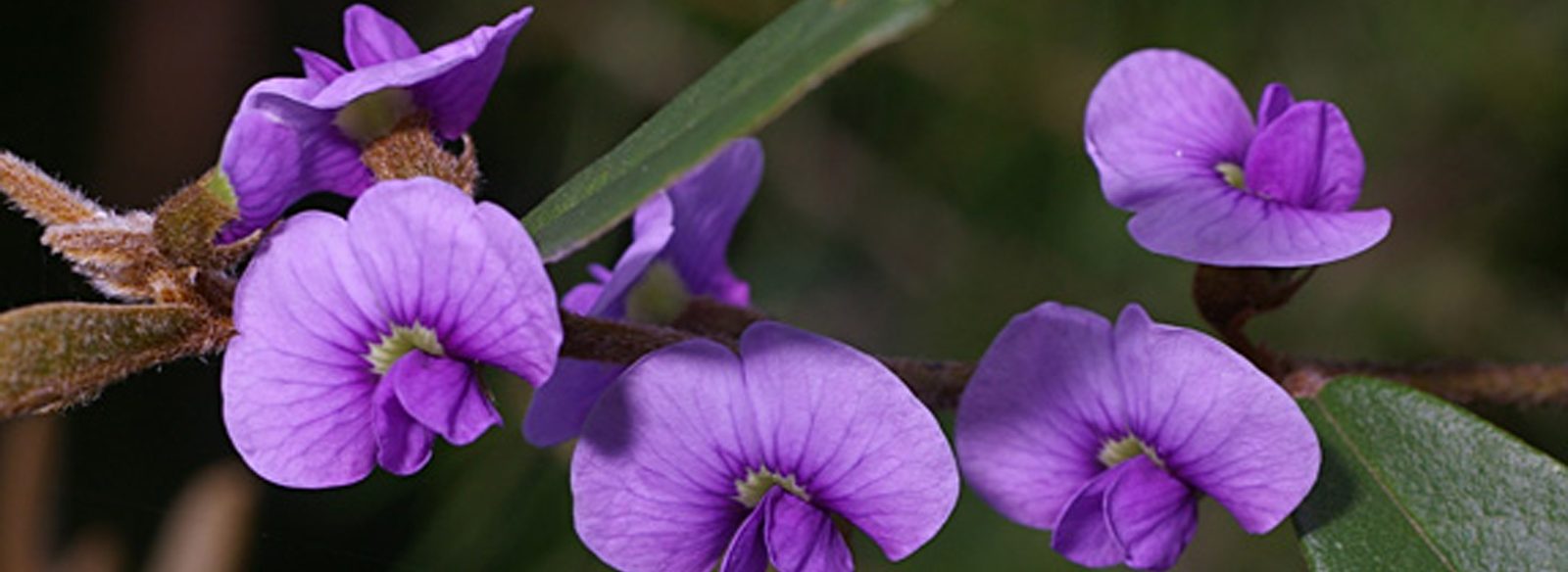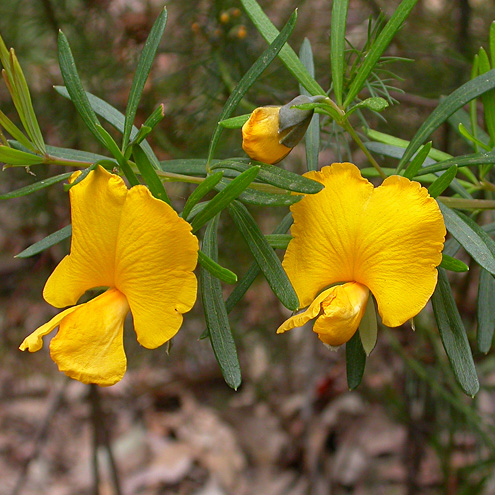Australian Pea Flowers – Background
Introduction
In its broadest context, the ‘pea family’ of plants is a very large group comprising over 700 genera and 19,000 species and includes not just the typical ‘pea-flowered’ plants but others including wattles (Acacia species) as well as Cassia and its relatives. This broadly defined family (the Fabaceae) occurs throughout the world and consists of herbs, shrubs, trees and climbing plants. Some exotics, such as the edible peas and beans, clover, lucerne and sweet peas are well established as commercial or ornamental crops while others, such as English broom (Cytisus scoparius) and gorse (Ulex europaeus), have long since outlived their welcome in some areas and become environmental weeds.
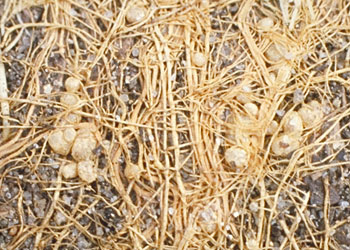 |
| Nodules on the roots of a “pea” plant can often be seen by removing a small plant from its container. Photo: Brian Walters |
The Fabaceae are legumes and are able to take-up (“fix”) their nutrient requirements for nitrogen directly from the atmosphere with the aid of soil bacteria (Rhizobium spp.). This occurs in nodules on the roots of the plants.
The botanical classification of the legumes is a little confusing. In Australia, until recently, most authorities classified them as belonging to three distinct families – Fabaceae (typical ‘pea-flowered’ plants), Mimosaceae (Acacia and relatives) and Caesalpiniaceae (Senna, Cassia and relatives). However, around the world the they have usually been classified in a larger Fabaceae family, with three subfamilies:
- Sub-family Faboideae – typical ‘pea-flowered’ plants (previously family Fabaceae)
- Sub-family Mimosoideae – Acacia and relatives (previously family Mimosaceae). The family/sub-family names based on the Mimosa genus.)
- Sub-family Caesalpinioideae – Senna, Cassia and relatives (previously family Caesalpiniaceae).
This latter classification now seems to have been adopted by Australian herbaria and is also used on these ANPSA pages. However, more recent studies indicate that a new classification comprising six sub-familes is warranted. Under this revised classification, the Mimosoideae would be included in sub-family Caesalpinioideae (see “New Subfamily Classification of the Leguminosae and Insights into Plastomes of the Mimosoid Clade“).
Note that the names Leguminoseae and Papilionaceae have also been used as alternative names for Fabaceae and that the sub-family Faboideae is also sometimes referred to as the sub-family Papilionoideae. To minimize confusion, these alternative names will not be used on the ANPSA site.
Sub-Family Faboideae – The ‘Typical’ Peas
This section of the ANPSA website deals with the Sub-family Faboideae – those members of the Fabaceae which have the typical “pea” flowers, as described below and as shown in the diagram. Another section of the website deals with the Fabaceae generally and there is also a section dealing with the genus Acacia.
In Australia, there are about 140 genera and 1,100 species in the sub-family Faboideae. They are found in every state and territory of Australia, from coastal cliffs to alpine areas, from the tropics to the arid inland. Many of Australia’s peas are representatives of genera found elsewhere in the world (eg indigo (Indigofera), coral trees (Erythrina) and rattlepods (Crotalaria). However, there are two groups (“tribes”) within the family which are almost entirely Australian:
“These are the egg-and-bacon peas, the tribes Bossiaeeae and Mirbelieae. They probably originated from a single common ancestor in Australia millions of years ago. All their ancestors have remained “true blue” except for a single species which has just managed to cross Torres Strait into Papua New Guinea. Together these tribes have 700 species, or more than half of all the peas in this continent. With few exceptions, they can be recognised by their distinctive “egg-and-bacon” flowers, in which the petals are yellow or orange with red markings……“
M D Crisp and J M Taylor, “Australian Plants”, June 1993, p102
Characteristics of the Sub-Family Faboideae
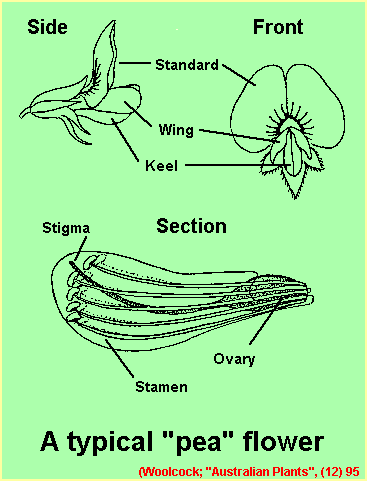
The main identifying characteristic of members of the sub-family Faboideae is the structure of the flower.
The typical “pea” flowers consist of 5 irregularly shaped petals; the “standard”, two “wings” and two lower petals joined along their upper edge to form the “keel”, as shown in the diagram. The keel encloses 10 stamens, the structure of which helps in distinguishing the various genera within the family. The stamens may be:
- All individually free (eg. Aotus, Chorizema, Dillwynia, Oxylobium, Phyllota, Pultenaea) as indicated in the diagram
- All fused into a tube (eg. Bossiaea, Hovea, Platylobium, Templetonia)
- Nine fused and the tenth one free (eg. Glycine, Hardenbergia, Kennedia)
In some cases the petals may be modified to a great extent such that the “typical” shape is not apparent at first glance (eg. Gastrolobium celsianum, Swainsona formosa). The most common colour among the pea flowers is yellow, often with a red or orange centre but colours of every shade from red through to white can be found in this group.
The flowers are followed by pods (legumes) which contain few to many hard seeds and which vary greatly in shape…..flat, short, elongated or cylindrical.
Like the acacias, many pea-flowered species occur in areas where bushfires are common, such as dry forests and woodlands. In these habitats they are often “pioneer” species, quickly recolonizing burnt-out areas and then being gradually replaced by other species in the plant community. They are often helped in this role by ants which store the seeds underground. The seeds themselves often have a very long viability.
Some of the most common Australian genera are listed in the following tables:
|
Genus
|
Brief Details
|
|---|---|
|
Aotus
|
Small shrubs, mainly from Western Australia; about 15 species
|
|
Castanospermum
|
A single species (C.australe, the black bean); large tree native to Queensland and NSW
|
|
Chorizema
|
Small shrubs/twiners. all but one native to Western Australia; about 18 species
|
|
Daviesia
|
Small to medium shrubs from all states but mainly western Australian; about 120 species
|
|
Dillwynia
|
Small to medium shrubs from all states with most in NSW; about 24 species
|
|
Gastrolobium
|
Small to medium shrubs mainly from Western Australia; some toxic; over 100 species, including all species previously included in Brachysema, Nemcia and most Oxylobium
|
|
Jacksonia
|
Shrubs or small trees widespread except in southern Australia; about 40 species
|
|
Gompholobium
|
Small shrubs from all states; about 30 Australian species
|
|
Oxylobium
|
Small to medium shrubs from easten Australia. Western species now included in Gastrolobium
|
|
Podolobium
|
Small to medium shrubs from most states; 6 species formerly included in Oxylobium
|
|
Phyllota
|
Small shrubs from most states; about 10 species
|
|
Pultenaea
|
Small to large shrubs from all states; about 120 species
|
|
Swainsona
|
Annual and perennial herbs from semi arid and arid areas; about 84 species
|
|
Genus
|
Brief Details
|
|---|---|
|
Bossiaea
|
Small to medium shrubs from all states; about 50 species
|
|
Crotalaria
|
Herbs or shrubs; about 26 Australian species. Some toxic and some exotic species have naturalised
|
|
Goodia
|
Small shrubs from all states; 2 species
|
|
Hovea
|
Small shrubs usually with blue or purple flowers; widespread; about 20 species
|
|
Platylobium
|
Small shrubs; all states except Western Australia; 4 species
|
|
Templetonia
|
Small shrubs from all mainland states; about 11 species
|
|
Genus
|
Brief Details
|
|---|---|
|
Glycine
|
Light twiners from all states; about 15 Australian species
|
|
Hardenbergia
|
Normally climbers; 3 species from eastern and western Australia
|
|
Indigofera
|
Small to medium shrubs; pinnate leaves; about 30 Australian species
|
|
Kennedia
|
Climbers or prostrate plants from all states; about 16 species
|
Toxins and Tucker
Although no Australian member of this group has been seriously exploited as a food crop, some have been important as food for both aborigines and for the early European colonists. However, as some of the latter found to their cost, many of the native “peas” are also toxic unless the seed is prepared correctly. This usually involves soaking to leach out the toxin or heating to destroy the toxic chemicals.
Some of the species used for food include:
- Castanospermum australe, the black bean. The seeds of this species are toxic when raw and are prepared by roasting or soaking in water.
- Coastal Jack, Canavalia rosea (toxin removed by heat). This plant was eaten by members of James Cook’s expedition in 1770.
- Vigna lanceolata, maloga bean, from northern Australia
- Mucuna gigantea, burny bean.
The toxic properties of some species have also had an impact on agriculture by other means; ie. by being implicated in livestock poisoning. Nervous system malfunction is seen in poisoning of livestock by some Darling peas, (Swainsona species), and by Gastrolobium species.
The rattlepods, Crotalaria species, are also implicated in livestock poisoning. They contain pyrrolizidine alkaloids which accumulate in the liver and produce long-term damage which is often fatal.
“Horses and cattle are more susceptible to poisoning than sheep, but sheep have been poisoned by bluebush pea (Crotalaria eremaea ssp. eremaea) in western Queensland. Poisoned horses develop a condition called “walk-about disease” or “Kimberley horse disease” in which they become unaware of their surroundings and wander blindly. A major cause of this poisoning is Crotalaria crispata, a small plant common in the Kimberley region of Western Australia. Other Crotalaria species cause the disease in the remainder of tropical Australia.
In central and northern Queensland an unusual disease of horses is caused by two other species of Crotalaria, C. aridicola (Chillagoe horse poison) and C. medicaginea (trefoil rattlepod). Horses may develop a taste for these plants which damage the oesophagus (gullet) producing ulceration severe enough to stop the horse swallowing food.”
Dr Ross McKenzie, 1993 Bill Tulloch Memorial lecture to the Queensland Region of the Society for Growing Australian Plants
Australian Pea Flowers – Propagation
Introduction
Australian ‘pea-flowered’ plants are propagated by both seed and cuttings, the best method for a particular species being determined through experience.
Seed
The seed of pea-flowers is shed annually. When the seed is ripe the pods turn brown and split to release the seeds. By keeping watch on the ripening pods it is fairly easy to collect the seed before it is shed. In some cases, however, the pods are attacked by insects before the seed is fully ripe and this can result in the loss of much of the viable seed.
The seed has a hard coat which, in most cases, is impervious to water and germination will normally not occur unless some sort of pretreatment is first carried out. In nature this hard coating is designed to be broken down by the heat of a bushfire to allow the species to re-colonize burnt out areas.
This effect can be replicated in a number of ways but, for most species, the easiest is to pour boiling water over the seeds and allow them to stand overnight. The next day any seeds which have swollen are ready for sowing and can be removed; the remainder of the seeds can be treated with boiling water again and the process repeated for as long as necessary.
Another method of pretreatment is to rub the seeds between sheets of sandpaper to reduce the thickness of the outer coating so that moisture can penetrate.
The seed usually germinates well by conventional sowing methods in seed raising mixes. Pre-germination, by sowing into a closed container containing moist vermiculite or a similar material, is also a useful method. Using this method, germination usually occurs in 1-2 weeks and when the root has reached about a centimetre or so in length, the seedling can be placed into a small pot of seed raising mix.
Cuttings
Many of the pea flowers strike readily from cuttings of about 50-75 mm in length with the leaves carefully removed from the lower two-thirds. “Wounding” the lower stem by removing a sliver of bark and treating with a “root promoting” hormone both seem to improve the success rate, although wounding may increase the chance of a fungal infection rotting the cutting.
General Propagation
Further details on general plant propagation can be found at the Society’s Plant Propagation Pages.
Australian Pea Flowers – Cultivation
Introduction
The sub-family Faboideae of the family Fabaceae is such a large and diverse group of plants, which inhabit virtually every climatic niche, it is not possible to give more than a brief and fairly superficial guide to some of the more commonly seen genera and species. Despite the size of the Australian pea family, relatively few species are cultivated, even by enthusiasts.
Plants of woodland, heath and open forest
This group includes the so-called “bush peas” of the genera Pultenaea, Dillwynia, Aotus, Gompholobium, Daviesia, Phyllota, Podolobium and Oxylobium as well as the well known climbers or prostrate plants in the genera Hardenbergia and Kennedia. These are distributed throughout Australia and species for cultivation should be selected from those native to a similar climate to that of the grower. Almost invariably, these species require well drained soils and usually appreciate some light protection from full sun.
Many of this group are not in general cultivation and many are difficult to maintain for long periods. Species which are available and which are generally reliable in suitable climates include:
- Gastrolobium celsianum (syn. Brachysema celsianum) – small shrub, red flowers with a prominent “keel”
- Chorizema cordatum – small shrub, red and orange flowers
- Dillwynia juniperina – small shrub, prickly foliage, yellow and red flowers
- Hardenbergia comptoniana – climber, purple flowers (from Western Australia)
- Hardenbergia violacea – climber, purple flowers (from eastern Australia)
- Indigofera australis – small/medium shrub, mauve to pink flowers
- Kennedia nigricans – very vigorous climber, black and yellow flowers
- Kennedia prostrata – prostrate plant, red flowers
- Podolobium scandens (syn. Oxylobium scandens) – prostrate plant, yellow and red flowers
- Pultenaea capitellata – prostrate plant, yellow flowers
- Pultenaea villosa – medium shrub, hairy foliage, yellow flowers
Plants of the inland
The most commonly seen inland genus is Swainsona and the best known is S.formosa, Sturt’s desert pea (previously known as Clianthus formosus). This is a very desirable plant with grey, divided foliage and very large and showy red flowers (sometimes white). The plant is not easy to grow in humid areas but can be gown for several seasons in a deep container with a very well drained potting mix. It is more easily cultivated in Mediterranean climates (dry summer, wet winter) and in arid areas.
Other Swainsona species are sometimes seen in cultivation. S.galegifolia is an attractive small shrub with mauve/purple flowers.
Tropical species
This is perhaps the easiest group for general cultivation. Castanospermum australe, black bean, is the most commonly cultivated. It usually forms a medium tree to about 15 metres and produces large clusters of orange/red flowers followed by large legumes containing several large seeds. The plant is hardy in most temperate areas provided water is available but it will withstand extended dry conditions once established.
Crotalaria species are sometimes cultivated in tropical areas. C.laburnifolia (bird flower), from north Western Australia, is a shrub to about 3 metres which is hardy in sub-tropical and tropical areas in a sunny position.
The ‘Bush Peas’ – an introduction to the genus Pultenaea
Dorothy and Colin Woolcock
The following article is reproduced from the June 1983 issue of Australian Plants, the journal of the Australian Native Plants Society. The article was part of a longer article introducing Pultenaea and its close relatives and it was followed over the next six years by a series of articles describing the genus in detail (see the articles under the “Further Information” tab).
Introduction
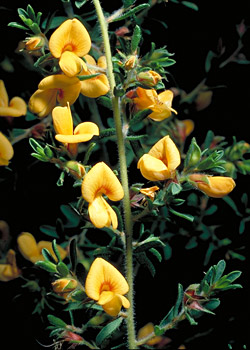
Photo: Brian Walters
Endemic in Australia, the interesting and complex Pultenaea group (about 120 species) is the largest genus of our native pea-flowers. Occurring in the temperate areas of all States, except the Northern Territory, it is widely distributed and frequently very common, with over 50 species found in New South Wales, almost as many in Victoria, 20-30 in both Western Australia and South Australia, and 10-20 in Tasmania and south-east Queensland. Some of these are very localised, and restricted to a small area of specialised habitat; others range through several states, producing massed displays of great charm and colour, frequently along roadside verges
Within their chosen habitats the bush-peas may be found in alpine and sub-alpine regions (particularly near swamps and bogs), in well-drained, montane forests, along the tablelands and in coastal woodlands, plains and heathlands — in good rainfall localities. A few species only will tolerate the low to moderate rainfall of mallee-type country and there they seek out the relatively damp depressions and soakage areas.
In this diverse group, which is also part of a very large botanical family, a few Pultenaea species tend to merge, in appearance, into closely related genera; but the great majority have a distinctive character and can be readily identified as belonging to this genus. The final identification of the individual species often depends on quite small changes in feature and structure.
As the popular name “bush-peas” suggests, most Pultenaea species are upright, often bushy shrubs, sometimes growing several metres tall, but frequently smaller, averaging between 0.5-2 m high. A few are either prostrate or procumbent, and the swamp species tend to be rather weak undershrubs, using neighbouring plants as support. Flowering time is usually from late winter through spring to early summer, though those from higher and wetter areas may be later still. Generally, but with a few exceptions, the flowers are yellow to orange in colour, marked or suffused with red, particularly the keel and the outside of the standard. The colour glow of a hillside or a gully of Pultenaea in full flower can be quite breathtaking.
Characteristics
Along with a number of other important genera, the Pultenaea genus is classed in the Mirbelieae tribe, in which the distinguishing factor is the stamen arrangement. Some of the related Mirbelieae genera (Phyllota, Dillwynia, Latrobea, Eutaxia, Aotus, Podolobium, Oxylobium and Gastrolobium), have characteristics which may fit a number of the following requisites but not all.
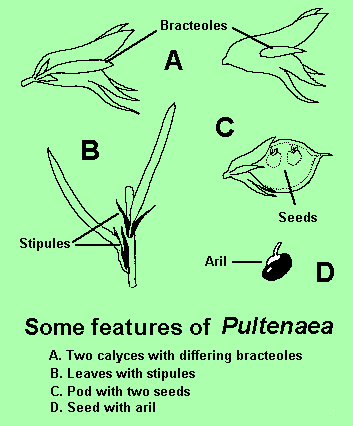
Stamens: Perhaps the first examination made in identifying any native pea-flower is to open gently the keel of a flower and check the stamen setting, preferably with a hand lens. All Mirbelieae, including Pultenaea, will have 10 stamens or filaments which are individually free to their base.
Stipules: These are defined as appendages growing in pairs at the base of leaf-stems adjacent to branchlet-stems. They vary in length from less than 1mm to 4-6 mm or even larger. Rarely, they are absent. The presence of stipules is not confined to Pultenaea, so that additional features are necessary to confirm the plant as a bush-pea. However, many Pultenaea species have prominent stipules, which impart a characteristic appearance readily recognised.
Bracteoles: These are bracts, usually in pairs, defined as occurring either on the flower stalk or the calyx-tube itself. Bracteoles may occur in genera other than Pultenaea, but their presence and appearance are helpful in establishing identity, as they are attached either at the calyx-tube base or on the tube itself. They vary in size, shape, complexity and attachment and can be simple, bilobed or trilobed. A hand lens is again recommended to check these details. Only rarely are bracteoles not present, although in some species they may be enclosed in additional (floral) bracts, which require careful removal. The presence of both leaf stipules and calyx bracteoles will establish the Pultenaea identity in many instances.
Seed Pods – Fruits: As shown in the diagram, the pod is ovate, not large, but larger than the calyx, and may be flat or swollen, with never more than 2 seeds. These pods open readily on maturing (dehiscent) and expel the seeds, so that one may find only empty pods if arriving too late. The individual seeds have a creamy-white growth, known as an aril, which is present on all Pultenaea seeds but not on those of some related genera.
Leaves: These may vary considerably in size and shape, are alternate, opposite or in whorls, but are invariably simple. If a plant has trifoliolate leaves (as in clovers, Glycine, Kennedia and others) or pinnate leaves (as in Swainsona, Indigofera) it cannot be a Pultenaea species.
Inflorescence: Flowers are in umbel-like heads, in axils of leaves clustered near ends of branchlets, axillary or solitary, never in extended racemes.
Australian Pea Flower Study Group
The Australian Pea Flower Study Group aims to further knowledge of this group of Australian native plants. Members of this study group focus on the identification, propagation cultivation, and conservation of members of Fabaceae (legume, pea or bean family) which have typical pea flowers. As in all study groups, the members’ work is carried out in their own homes and gardens and in their own spare time.
Information about the Australian Pea Flower Study Group, including access to its newsletter archive can be found at the following link.
***Click here to go to the Australian Pea Flower Study Group***
Australian Pea Flowers – Further Information
Most books dealing with Australian native plants will contain useful information on the botany and horticulture of the pea-flowered plants. Some of the most detailed references are listed below.
Books:
- Elliot, R and Jones D (1982), The Encyclopaedia of Australian Plants, all volumes, Lothian Publishing Company Pty Ltd, Melbourne.
- Symon, D and Jusaitis, M (2007), Sturt Pea, a Most Splendid Plant, Board of the Botanic Gardens and State Herbarium, and Department for Environment & Heritage, Government of South Australia, Adelaide.
- Wrigley, J and Fagg, M (1996 – 4th ed), Australian Native Plants, Reed Australia.
Journals:
Several issues of the Society’s journal “Australian Plants” are particularly useful for those interested in the Australian “peas”.
- Vol 4, No.35 June 1968: Phyllota; Poison pea flowers.
- Vol 10, No.82 March 1980: Crotalaria.
- Vol 10, No.79 June 1979: Australian Pea-flowers, Their Cultivation; The Plant Family Fabaceae.
- Vol 11, No.86 March 1981: Peaflower Plants of Australia; Psoralea; Glycine.
- Vol 11, No.87 June 1981: Bossiaea and related genera (includes, Platylobium, Hovea, Templetonia, Goodia).
- Vol 11, No.89 December 1981: Sturt’s desert pea – history, cultivation and propagation; Grafted desert peas.
- Vol 12, No.95 June 1983: Pultenaea Part 1.
- Vol 12, No.99 June 1984: Pultenaea Part 2.
- Vol 13, No.102 March 1985: Pultenaea Part 3.
- Vol 13, No.106 March 1986: Pultenaea Part 4.
- Vol 13, No.107 June 1986 Pultenaea Part 5.
- Vol 14, No.111 June 1987: Pultenaea Part 6.
- Vol 14, No.112 September 1987: Pultenaea Part 7.
- Vol 14, No.115 June 1988: Pultenaea Part 8.
- Vol 14, No.116 September 1988: Pultenaea Part 9.
- Vol 15, No.119 June 1989: Fabaceae – the Pea-flowered Wildflower Family; Pultenaea Part 10; Gompholobium.
- Vol 15, No.120 September 1989: Pultenaea Part 11.
- Vol 15, No.124 September 1990: Sturt’s desert pea.
- Vol 17, No.135 June 1993: Chorizema.
- Vol 17, No.138 March 1994: Burny bean – Mucuna gigantea.
Internet:
- ‘Dusky’ – The Runaway Coral Pea
- Everything New is Old Again; Is it a Gastrolobium?? Probably….
- Family Fabaceae – faboideae. Botanical details from the Royal Botanic Gardens, Sydney
- Growing Native Plants – a series of plant profiles by the Australian National Botanic Gardens; includes a number of species of Australian “peas”.
- Gompholobium: The Glory Peas
- New Subfamily Classification of the Leguminosae and Insights into Plastomes of the Mimosoid Clade“.
- The Pea Key; An interactive key for Australian Pea-flowered Legumes.
- Wallum Pea Flowers
 Australian Native Plants Society (Australia)
Australian Native Plants Society (Australia)